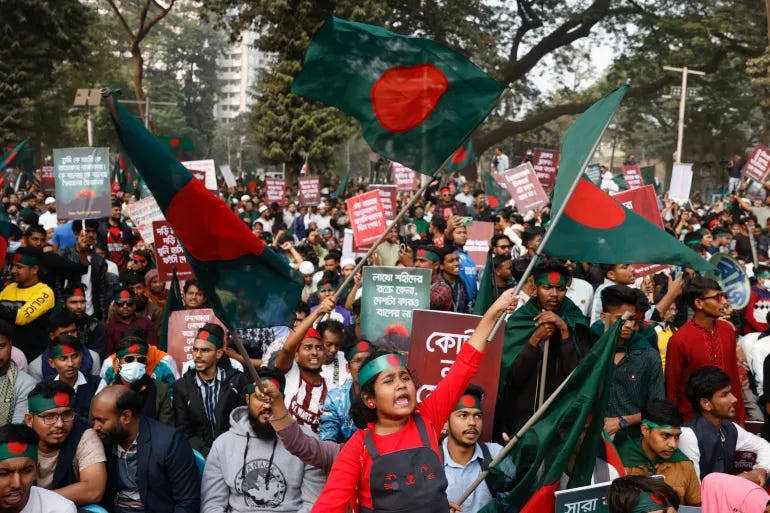Can the Awami League Rebuild After Its Fall from Power?
Five months after Sheikh Hasina’s ousting, the party faces internal division and calls for accountability from grassroots activists.
Dhaka, Bangladesh — In the aftermath of Sheikh Hasina's dramatic removal from power in August 2024, the once-dominant Awami League finds itself fractured, grappling with its role in the deadly student-led uprising that toppled the 16-year regime. While the party’s high-ranking members remain defiant, many at the grassroots level are calling for reflection and accountability, fearing that the path ahead for the Awami League may hinge on how it addresses these divides.
The triggering event of the political collapse occurred on July 16, 2024, when police shot and killed student leader Abu Sayeed during a protest in Rangpur. Meanwhile, in the capital Dhaka, Abdur Rahman, a senior member of Hasina's administration, appeared unfazed by the violence that was sweeping across the country. A video taken on that day shows Rahman enjoying a poetry recital as the situation escalated. When told about the protests, he dismissed them with a cavalier remark: “Oh, nothing will happen. The leader [Hasina] will handle everything.”
This stark contrast between the minister’s complacency and the chaos unfolding on the streets came to symbolize the Awami League's disconnection from the country’s citizens. Less than three weeks later, the government was overthrown, with over 800 dead and 20,000 wounded in clashes with security forces. Hasina fled to India as the student protests culminated in her government’s collapse.
A Party in Disarray
In the months following Hasina’s ouster, the Awami League has been unable to unify. Senior leaders like AFM Bahauddin Nasim continue to point fingers at an "international conspiracy" for the party's downfall, refusing to acknowledge internal mistakes. Analysts suggest that this denial of responsibility is contributing to the party's growing alienation from its base.
Many former activists now lament how the Awami League became more of a hierarchical, top-down organization over the years, sidelining grassroots participation in favor of family connections and opportunistic figures. A former Bangladesh Chhatra League (BCL) leader described the moment when Hasina’s helicopter left the capital as a turning point: “At that moment, I felt cheated.”
The sentiments of betrayal are widespread. Grassroots Awami League members, like Samiul Bashir of the Bangladesh Krishak League, say that since 2014, the party has been dominated by opportunists who abandoned loyal activists. These disillusioned members express their anger on social media, claiming that the Awami League’s heavy reliance on intelligence reports instead of grassroots input contributed to its downfall.
No Apology from the Leadership
Despite the widespread violence and loss of life during the July uprising, the Awami League has yet to issue a formal apology or take responsibility. Instead, the party continues to describe the protests as a "terrorist uprising," blaming opposition groups for orchestrating the violence. Nasim, in an interview, repeatedly accused the Islami Chhatra Shibir, the student wing of the Bangladesh Jamaat-e-Islami (BJI), of misleading students under the guise of the anti-quota movement. He also cited “intelligence lapses” as the primary reason for the government’s failures, a view echoed by other high-ranking party officials.
In contrast, figures such as Tanjim Ahmad Sohel Taj, son of Bangladesh’s first Prime Minister, argue that the party's lack of self-reflection and accountability is a critical issue. He told media outlets, “The Awami League must apologize for the injustices, corruption, and billions laundered during its reign.”
A Challenging Road to Recovery
Rebuilding the Awami League will be no easy feat. Historically, Hasina has proven resilient, having rebuilt the party in the 1980s after spending years in exile following her father’s assassination. However, political analysts believe that this time the challenge is more formidable. The Awami League faces a crisis of leadership and image, with many questioning whether it can recover from the bloodshed of 2024.
Some members, particularly from the BNP and Jamaat, are calling for the prosecution of those responsible for the killings during the uprising. But it is the student-led movement that remains steadfast in its demands. Key figures in the movement, including Mahfuz Alam, have made it clear that the Awami League will not be allowed to participate in the next election unless it faces accountability.
In the view of political analyst Ali Riaz, the Awami League faces a steep climb to regain public trust. He argues that for any chance of a comeback, the party must meet four conditions: issue an unambiguous apology for its role in the 2024 uprising, renounce its current ideological stance, ensure that no member of Hasina's family leads the party again, and hold trials for crimes committed under its rule.
While a faction of senior Awami League members remains loyal to Hasina, others have become increasingly vocal in their criticism. Many party activists, particularly those hiding in fear of legal action, believe that a political comeback feels a long way off. As one anonymous former student leader put it, “The party abandoned us. I’ll never return to politics.”
The Future of Bangladesh’s Awami League
For now, the Awami League is at a crossroads. Whether the party can regain its footing, heal the rifts within its ranks, and win back the trust of the Bangladeshi people will depend largely on how it handles the aftermath of the July uprising and addresses the calls for accountability. With elections looming, the clock is ticking for the Awami League to prove that it can rise from the ashes of its violent past or face an uncertain future.


